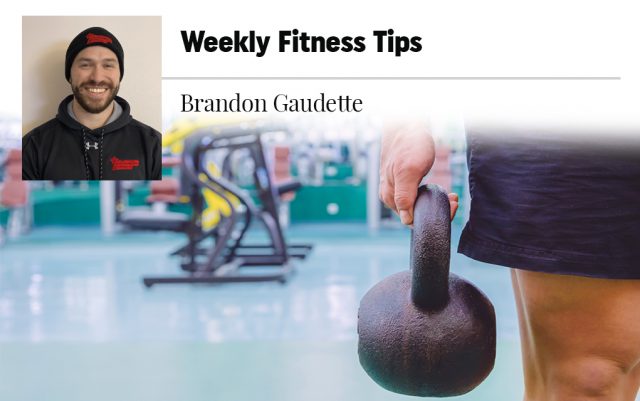Whether your goal is to get stronger, lose belly fat, or just improve your general health, keeping things simple is the best way to do that.
We are surrounded by new fad diets and training programs promising results in a short amount of time, giving us the hope of a quick fix. However, there is no such thing as a quick fix. Changing your body requires effort. If you can create a routine that is simple to follow, it will greatly increase your chances of success.
I want to show you how you can build your own exercise routine around six movements that I use personally and explain why these movements are key to creating a strong, well-rounded body. These movements are in my opinion essential to a quality resistance training routine. The six fundamental movements are: the hinge, squat, push, pull, lunge, and carry.
Why these six you ask? Let’s break it down:
The Hinge
Better known as the deadlift, the hinge is one of the best exercises we can do to strengthen the entire backside of our body. It strengthens our posterior chain of muscles including your glutes, hamstring, calves, and lower back while also increasing our grip ability. When executed with the proper volume, load, and technique this movement will improve posture and total body strength.
The Squat
Well known as having been called “the king” of all lower body exercises due to its ability to help build impressive strength and muscular growth. It trains our quads and glutes primarily while also helping to strengthen our core. Squatting will help restore the mobility, strength and function of our hips and ankles while allowing the trainee to help undo some of the restrictions developed by sitting all day long.
Upper Body Pushes
Can be done both vertically (overhead) and horizontally (in front) and are important to build strength in our chest, shoulders and triceps. Having strength in our upper body pushing muscles gives us the ability to lift things overhead and in sport to push things away. Having adequate strength in our upper body helps create stability and avoid shoulder injuries and develop muscular symmetry.
Upper Body Pulling
Again, can be done both vertically and horizontally to develop our lats, biceps and shoulder blade muscles. Working on pulling strength is very crucial today because most of our daily tasks are performed on a computer while sitting in a chair. When we work in a chair or on a computer for an extended period of time, our shoulders start to get pulled forward (tight chest) and our upper back starts to round, lengthening and potentially weakening the muscles involved. When we perform pulling exercises, we strengthen the muscles in our back and trunk to help with strength, symmetry, and posture.
The Lunge
Variations of the lunge are fundamental when it comes to building single-leg strength. Single leg movements carry over massively to life or in sport due to its similarity to walking and running. When navigating in sport or life we often find ourselves on one leg. Having good single-leg strength is a good indicator for injury prevention as it demonstrates strength and stability of the hips, leg, and core.
Carries
An extremely important exercise that trains our core, posture, and grip strength. Performing carries while having a load on each side will help you develop brute strength while carrying a lighter load improves endurance and work capacity. If you load one side, this will train cross stabilisation of your core. Using different types of carries in your program will give you amazing results and a strong, resilient core.
Bringing all six movements together into your training program will help you build a strong, resilient body with good posture. It is effective for improving many different fitness components from losing weight to adding lean mass. As you get stronger and master the basics of each movement, they have endless modifications giving you the ability to continually strive for more, try new things, and avoid a stagnant workout routine.
Now that we have talked about the six basic movements and why they are important, how do you get started? I would get started with 2-3 full-body workouts a week that incorporate one exercise from each movement pattern. Try to perform 3 sets for each exercise and a weight that allows 8-10 repetitions.
Here is an example of a workout to get you started.
1. Leg Pull: Kettlebell hinge (deadlift) 3 sets 10 reps
2. Leg Push: Kettlebell Goblet squat 3 sets 10 reps
3. Upper Body Horizontal Push: Push up 3 sets 10 reps
4. Upper Body Horizontal Pull: Trx row 3 sets 10 reps
5. Lunge: Reverse or forward walking lunge 3 sets 10 reps
6. Carry: Kettlebell one side loaded suitcase carry 3 sets 20m each side
You can perform this in a circuit or perform all three sets of each exercise with sufficient rest before moving on to the next one. Try following this program for four weeks and see what you can accomplish!
When building an exercise program, start with planning to use these six foundational movements. Work on the proper form and execute the exercises with focus and intention. Remember to be patient and strive for improvement and you are sure to see results. Happy training!
By: Brandon Gaudette
Brandon is a Georgian College Fitness and Health Promotion graduate, and Canadian Society of Exercise Physiology Certified Personal Trainer (CSEP-CPT). His journey began when he attended Georgian College playing junior hockey. While at Georgian, he got the opportunity to work as a strength coach at an institute located in Barrie. He was able to work with athletes of all ages developing his coaching skills. After graduation he wanted to try something different and searched for a new role, a search that led him to his position today with Personnel Support Programs (PSP) where he has been a Fitness instructor for 6 years.
Want more content like this?
This article is part of the Borden Citizen “Weekly Fitness Tips” series. Click here for more content like this, and subscribe to the free Borden Citizen weekly newsletter to make sure you don’t miss the next one!












